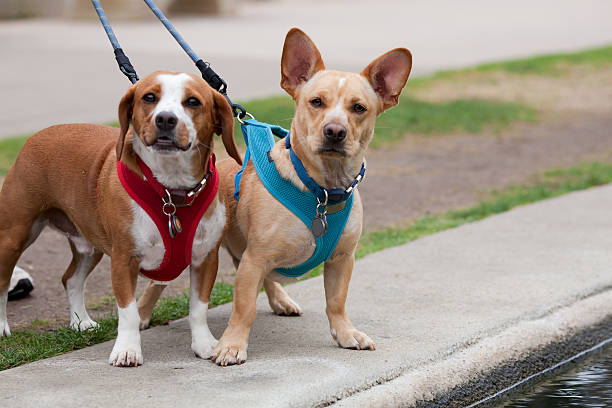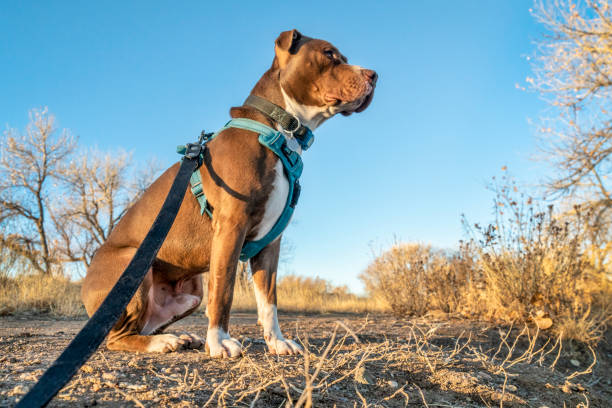Learn How To Wear A Dog Harness. Did you know that some dogs who use the standard collar and leash setup may be more susceptible to neck injuries? Your dog may experience whiplash and bruising damage from jerking back the leash, which will be extremely painful and uncomfortable.
In more severe circumstances, jerking the leash might fracture the vertebrae and compress the windpipe. Some dog breeds, such as Chihuahuas, Pomeranians, Shih Tzu’s, Lhasa Apsos, Toy Poodles, and Yorkshire Terriers, are predisposed to developing trachea collapse. Most of the time, owners do not mean to harm or endanger the health of their cherished pet, but this can be prevented.
Investing in a harness for your adorable dog is a fantastic substitute for a collar and leash! When your dog is wearing a properly fitted harness, the pressure is distributed throughout the dog’s entire body rather than just the neck region. The harness should fit tightly to ensure that your dog is both secure and comfortable.
Additionally, using a harness can be a preferable option for the owner because it gives you more control over your dog and lessens the possibility of the leash tangling with its front legs. Remember that it could take some time for your dog to become used to wearing a harness if you’re trying it for the first time. While some dogs adapt quickly, others might need some time and tasty goodies. Standard dog harnesses come in a vleaariety of styles.

Common Dog Harness
Different harnesses require different methods for putting them on. Let’s begin by going through how to put on a normal harness. A typical harness has a D-ring on the dog’s back where the leash is attached, two loops around the ribcage, and one loop around the neck.
- Position your dog in a standing or sitting position as you stand, sit, or squat behind him. When your dog is quiet is the ideal time to accomplish this.
- Put the dog’s head in the harness. Ensure that the D-ring on the harness is on your dog’s back. The broader loop (the one with the buckle) is put on first, followed by the smaller loop.
- Thread your dog’s leg through the harness’s first leg hole. The leg should now be situated halfway between the loops around the ribs and the neck.
- Fasten the harness so that the other leg of your dog is in the appropriate leg hole. You must loosen the strap if the buckle is too short for you to close.
- After fastening the harness, make adjustments for a perfect fit. Any strap should be wide enough for two fingers to fit underneath. To ensure the harness is on your dog securely, try pulling it over its head.
Canine Step-In Harness
Let’s now examine how to put on a step-in harness. A step-in harness is different from a regular harness in that it forms triangles around your dog’s legs, while the former forms rectangles.
- Lay the harness flat so you can see the two triangles properly. The buckles need to be placed above the D-rings.
- While holding your dog behind you, position his front feet in the two triangles.
- Take the harness’s two ends and clip them together behind your dog.
- Correctly adjust the harness. To ensure it is fastened, attempt to pull it over your dog’s head.
Dog harness with front clip
Let’s look at the front-clip harness installation last. A front-clip harness is made to prevent tugging by having the leash clip over the dog’s chest in the front. Some front-clip harnesses have the same shape as the step-in or conventional harness. If so, adhere to the instructions for those harnesses.
One loop that wraps around the ribs and a single strap that crosses the chest are the features of some front-clip harnesses, though. The space between the dog’s legs is unobstructed. If your harness is of this type, proceed as described below.
- While your dog is calmly sitting or standing, kneeling to his right side.
- Place the harness loop over your dog’s head. On his left shoulder should be the label for the harness, and in the middle of his chest should be the metal ring for the leash.
- Tighten the belly strap by extending your hand underneath your dog’s tummy.
- Make the harness fit your dog properly. Make sure you can’t get it past him.
While certain harnesses can be challenging to use at first, they’re simple once you get the hang of them. Making sure the harness is secure but not too tight is the most crucial step in ensuring the safety and security of your furry pet.

Benefits and Drawbacks of Collars and Harnesses
So, should your dog wear a collar or a harness? You should wear a collar and a harness together.
Harnesses
Your dog won’t suffer neck injuries thanks to a harness. The dog’s shoulder blades and chest feel the pressure and force of the leash being pulled back. The dog benefits more from equitable force distribution because its main body is much stronger than its neck. In addition, several dog breeds, such as Chihuahuas, Pomeranians, Shih Tzus, Lhasa Apsos, Toy Poodles, and Yorkshire Terriers, are more likely to have trachea collapse. These dogs should unquestionably walk with a harness rather than a collar.
Another safety aspect is that your dog is less likely to choke if it escapes and gets tangled up in its harness. A minor knot that crosses their chest cannot immediately be problematic.
You can acquire a variety of harness designs. Every size of the dog, every style, and every desire may be accommodated by a Neewa harness.
Collars
For most dogs, securing a leash to a collar is not the ideal option. You risk accidentally straining their neck and trachea when you tug on the leash. Whiplash, vertebral fractures, breathing difficulties, and strangulation from a collar and leash attachment are all possible injuries for your dog’s best friend.
Some dogs have heads and necks almost the same size, making it quite simple for the collar to come off. Typically, this comprises breeds with thin heads, like Greyhounds, Whippets, Salukis, and others. For these dogs, a harness is the best choice.
But in addition to the harness, employing a collar without a leash can be a smart option. An attractive collar that can be used for identification is Neewa’s sport collar. If your dog wanders off, you can engrave your contact information and information about your dog’s rabies vaccination on the collar tag.
Which harness would be ideal for your dog?
Dog harnesses come in a few different designs, so picking the right one for your dog may require trial and error. The way a harness is put on the dog—step-in versus over-the-head—or the location of the leash attachment is often used to distinguish them. The location of the leash attachment is the key difference between the two since it impacts how you handle your dog.
Let’s examine the three most popular kinds of harnesses:
Front-clip Harness
Leash attachments on front-clip harnesses fit in the middle of the dog’s chest. These harnesses are frequently employed to prevent dogs from tugging.
When your dog pulls, you can yank them back toward you by attaching the leash to the front of the harness, which serves as a constant reminder for them to turn to you for guidance.
Front-clip harnesses are useful for steering your dog, but if there is any slack in the leash, they frequently tangle around the dog’s legs. This might not be very pleasant for you and your dog, especially if you want to take your dog running.
Belt with a back clip
The leash of a dog wearing a back-clip harness is connected to a loop on the dog’s back, typically between the shoulder blades. Small dogs are wonderful candidates for these harnesses because they keep the leash out of the way of their legs while yet allowing you complete control over the dog.
Harness with two clips
With a dual-clip harness, you may pick where to attach the leash because there are clips on both the front and back of the harness.
A dual-clip harness might be a good place to start if you are unsure which placement will work best for your dog.
Patience is essential when putting on a dog harness for the first time. Of course, there’s a good probability that everything will go smoothly and your dog will be agreeable. If not, try again and give yourself lots of praise along the process. Also, keep in mind that many different kinds of harnesses are available; it can take some trial and error before you locate the best one for your dog.

How tight of a dog harness is recommended?
Dog harnesses need to fit snugly so your dog can’t get out. However, it should also fit snugly enough to prevent your dog from feeling pressure.
Comfort
The uncomfortable absence of cushioning is one of the main reasons a dog cannot enjoy its harness. While not the cheapest, a high-quality harness will have adequate cushioning in all the correct areas. Generally, all straps on the harness, including those under the dog’s belly, should be wide enough for two fingers to fit below. This guarantees your dog’s comfort. Both you and your dog would never want to wear anything too tight!
Safety
Try carefully pulling the harness over your dog’s head to ensure it is secure. To avoid upsetting your dog, move gently and cautiously throughout this process. The harness needs to be adjusted if it can be removed over his head without being hurt.
This issue must be resolved because the harness can come off if your dog tugs on the leash. Your dog can become hurt or lose himself as a result of this.
Conclusion
A harness is a safest, most cosy, and most secure method of fastening a leash to your dog. Take the time to measure your puppy to ensure the correct fit, as a harness that isn’t fitting properly can hurt your dog just as much as a collar does. You can easily put a harness on your dog using the abovementioned techniques. Spend some time practising positive reinforcement training to make the process easier if your dog refuses to let you put the harness on him.
You may choose a dog harness from Neewa’s wide selection of accessories for every occasion.
You can also find a great range of collars for your dog to use alongside a dog harness. If your dog wanders off without you, make sure it can be found again.
